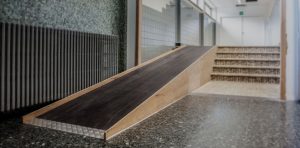Prestressing mechanism
1.Prestressing is a technique that improves the mechanical properties of a material by applying an external force or deformation.
2.In plywood, prestressing can be applied by stretching, bending or twisting the ply.
3.Prestressing changes the internal stress distribution of plywood and improves its ability to resist bending deformation.
Principle of prestressing
Prestressing means applying a certain stress to the plywood veneer before gluing, so that the veneer still maintains some stress after gluing. When the plywood is subjected to bending load, the reaction force generated by the prestressing is consistent with the load direction, thereby offsetting part of the bending stress.
Prestressing improves the bending stiffness of plywood
The bending stiffness of plywood refers to its ability to resist bending deformation. In engineering applications, improving the bending stiffness of plywood is of great significance. Prestressing is an effective means to significantly improve the bending stiffness of plywood.
Prestressing method
Common prestressing methods include:
*Cold bending method: cold bend the plywood veneer into a certain curvature, and then glue. After the veneer releases the curvature, prestress is generated.
*Hot bending method: heat and soften the plywood veneer, then bend it into a certain curvature, and glue it after cooling. The veneer cools and shrinks, generating prestress.
*Compression bending method: apply vertical pressure on the plywood to make it bend and deform, and then it. After releasing the pressure, the veneer rebounds and generates prestress.
Influencing factors
The lifting effect of prestressing is affected by the following factors:
*Prestressing size: The greater the prestressing, the more obvious the lifting effect.
Application method: Different prestressing application methods produce different prestressing distributions, which affect the lifting effect.
*Gluing strength: Gluing strength determines whether the prestressing can be effectively transmitted to the plywood.
*Veneer thickness: Veneer thickness affects the convenience and effectiveness of prestressing.
Application
Prestressing technology has been widely used in the production of plywood.
*Lightweight partition wall: Prestressed plywood has high bending stiffness and can be used to make lightweight partition wall with good sound insulation and earthquake resistance.
*Curved furniture: Prestressed plywood can be bent into various curved shapes and is widely used in the manufacture of curved furniture.
*Ship deck: Prestressed plywood is used in ship deck to improve the stiffness and durability of the deck.
Conclusion
Prestressing is an effective means to significantly improve the bending stiffness of plywood. By optimizing the prestressing method and parameters, the structural performance of plywood can be further improved to meet the needs of different engineering applications. With the development of technology, prestressing technology will be more widely used.
Bending properties of composite reinforced plywood
Composite material reinforced plywood bending performance
1.Fiber-reinforced composite materials, such as glass fiber, carbon fiber and aramid fiber, have the advantages of high strength, high stiffness and light weight, which can effectively improve the bending stiffness of plywood.
2.Composite plywood with excellent bending performance can be created by laminating or sandwiching composite materials with plywood substrates.
3.Factors such as the number of layers, orientation and fiber volume fraction of the composite material have a significant effect on the improvement of bending stiffness.
Composite materials enhance the bending performance of plywood
As a widely used engineering material, the bending stiffness of plywood has always been one of the key factors affecting its structural performance. The introduction of composite materials provides new ideas and technical means to improve the bending stiffness of plywood.
Ⅰ.Introduction to Composite Materials
Composites are heterogeneous material systems composed of two or more materials with different properties. They usually consist of reinforcement materials and matrix materials. The reinforcement materials have high strength and stiffness, such as carbon fiber, glass fiber or aramid fiber; the matrix material is the material that binds the reinforcement materials and bonds them together, such as epoxy resin, phenolic resin or polyurethane.
Ⅱ.The mechanism of composite materials to enhance the bending stiffness of plywood
The mechanism of composite materials to enhance the bending stiffness of plywood is mainly reflected in the following aspects:
1.Improve the section modulus
The elastic modulus of composite materials is usually much higher than that of the base material of plywood (such as wood). Pasting composite materials to the surface or inside of plywood can effectively increase the section modulus of plywood, thereby improving its overall stiffness.
2.Reduce bending deformation
Composite materials have high bending strength and bending modulus. When plywood is subjected to bending load, the composite material layer can withstand greater stress, reduce the bending deformation of plywood, and thus improve its bending stiffness.
3.Improve interlaminar shear strength
The interlaminar shear strength of composite materials is also usually higher than that of plywood. Pasting composite materials between the layers of plywood can improve the interlaminar shear strength of plywood, prevent interlaminar sliding of plywood during bending, and thus improve its overall bending stiffness.
Ⅲ.Application of composite materials to enhance the bending properties of plywood
The research results of composite materials to enhance the bending properties of plywood have been applied in practical engineering
The application areas mainly include:
*Load-bearing components in bridges and building structures
*Lightweight components in the automotive and aerospace industries
*Thermal insulation and structural materials in ships and marine engineering
Ⅳ. Summary
The introduction of composite materials provides an effective way to improve the bending stiffness of plywood. Its strengthening mechanism includes increasing the section modulus, reducing bending deformation and increasing interlaminar shear strength. Related research shows that composite materials have a significant effect in enhancing the bending stiffness of plywood and have broad application prospects in practical engineering.

